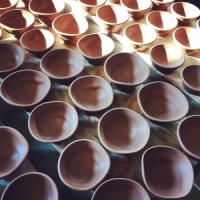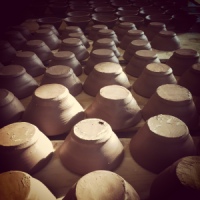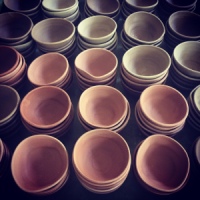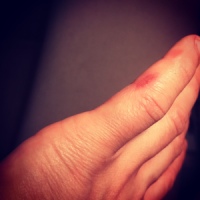My students finish out the school year by packing their bags. They depart soon after the last class for service trips in foreign countries, sports camps at colleges, or down time at the shore house. I need to pack my own bags soon, to begin my second summer of work in Michigan. But for the last week since graduation, I have been standing still.
Or – not exactly standing. I’ve been sitting at the wheel.
The second of many emails from the summer job is a reminder that I should bring work for the faculty show. My heart sank. This year was far too frenetic for me to find a rhythm between making and teaching art. I worked myself to the bone trying to maintain my balance and sanity with the teaching part. Although this was my eleventh year in the classroom, an experimental new schedule left me feeling like a raw beginner.
Any school year reflects back in memorable snapshots, so here is one of mine. My Ceramics I students are setting up displays for the second semester art show. I am huddled in the back of the office adjoining the studio, fighting tears that almost blew my teacher-cool.
Yes. Me. Tough-as-stoneware, try-it-again, kiln goddess me, sniffling back sobs.
These students were a joy to teach – enthusiastic, persistent, cooperative, and just edgy enough to keep classes fun. But after years of teaching craft on a daily schedule, my classes were now scheduled on asynchronous days. Sometimes I did not see my students for four or five days in a row. We lost the practice, repetition, and immersion that it takes to learn a new skill.
Sure, my students learned to work with clay. They had ceramic work to show, and they seemed proud of the pieces they were arranging on folding tables. Yet I was acutely aware of the difference between this year’s displays and what my students had been able to accomplish in the past. In terms of quantity, quality, overall creativity, and depth, we had not reached the levels of previous years. I felt like I had let my students down. Maybe worse, it felt like I’d worked harder than ever for lower results.
So it took me a few unexpected tissues to get through the art show setup. Don’t worry – I pulled it together in time that the teenagers never saw my weakness. Red eyes were blamed on a late night updating grade books. Nothing unusual about that excuse.
Harder work for diminished returns took its toll on my artist-self. I saw to it that our Empty Bowls event ran smoothly. I made some mugs for my graduating seniors. I did a few teapot demos. But when there was a choice between putting in few more hours of personal studio work at the end of a long day of spinning wheels (literal and metaphorical), or sinking into the couch to binge on Netflix, streaming television won every time.
I’ve been exhausted. I’ve been a little frustrated at times. I’ve developed other interests. I have been anything but an artist, but the email insists it is time for me to be one.
So I sat down at the wheel after graduation, feeling a little numb and a lot tired. I have a very rough idea of what I am making. Here is not the place to describe it, and I am really not sure it is going to work. The first day, I put in six hours or so; the second day, eight; the third day, nearly ten. I dulled my mind with some repetitive music and a podcast or two, and sank into the rhythm of making half-pound bowls.
Somewhere along the way, I hit flow. I lost track of time; my mind quieted; my hands and body took over. When I carried the bowls to the table, I noted the difference between the first pieces and the later sets. Early bowls were tight and weighty. Bowls thrown two or three hours in were lighter and a lot more fluid. I remembered how much I love this transformation-by-practice. It’s a given, a guarantee: when I put in the time, my craft improves. It is one of the truest and most rewarding forms of learning I have ever experienced.
I doubt whether I can provide this studio immersion to my students anymore. It’s not that the experience is foreign to them. At athletic practices, many of them spend this depth of daily time and practice on the court or field. A few of them understand it from other extracurricular experiences. So we can talk about it. I’ve asked them to write about it and discuss it. I theorize that the flow experience is why many of them self-identify as athletes. Maybe – if we are lucky – one or two of them find real immersion in the studio. They stay for an open studio, or a sports practice is cancelled and the studio door is open. They get to work for a few hours, and that time flies by in a way that hooks them into further practice. But when we do not meet daily, and daily practice is not part of their busy lives, it feels impossible to reach the depth of previous years without circumstantial opportunity.
I wonder what the scheduling means for finding immersion in other areas that benefit from daily practice, too. Is it harder to identify as a writer when you do not practice writing every day? As a scientist, if you do not get fully immersed in the lab? I suppose that you can practice writing or math or coding daily from anywhere. That’s what concepts like mobile learning and blended learning are all about. We assume that they will practice the skills on off-days. We post the work online and wait for responses in our inbox.
But craft and studio work require that students practice outside of scheduled time. No assuming involved. Maybe you can watch a demo video, but the skills do not stick unless you get to practice them soon after watching. As I noticed that even committed upper-level students were not able to work in the studio outside of class without superhuman effort or circumstantial opportunity, empathy took over. I scaled back my expectations. Could it simply be that experiences that require localized practice – like throwing on the potter’s wheel, or designing in the Adobe suite – are becoming obsolete?
Last year, a group of students who read Malcolm Gladwell’s essay on practice asked me how many hours I have spent practicing on the wheel. I was a little embarrassed to admit that it has to be more than 10,000 hours now. I feel like I should be a master potter, and I am far from it. But I do not regret a single moment of that time, whether the craft is obsolete or not. That immersion in practice is how I came to identify as an artist, once – and maybe it is where I will find that identity again.
I hope that when I have 10,000 hours of practice in new models of teaching and learning – if that is even possible in such rapid evolution – I will similarly have no regrets. Maybe I need to find this patience. Maybe I will even start to improve. Maybe I will at least get through an art show without tears.
No surprise: When I try to find the full text of the Gladwell essay on Google, I instead find search-fulls of articles debunking it.
Examining 170 trimmed bowls on the table, created for my first personal work in a long time, I am standing still. I am on pause before I pack my bags and and move on to new students and new ideas. Before I adapt to new systems.
The practice time, the immersion, the pause – all of it simply feels good. And although I put on my enthusiastic teacher-face every day, it’s been awhile since I felt really good in the studio.
I’m pausing for now. And it’s time to finish a piece.










